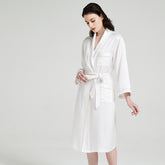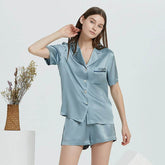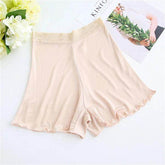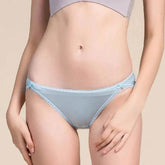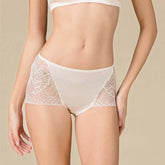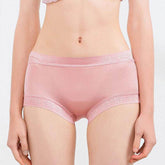The Perfect Silk Pajamas Set for Women: Comfort Meets Luxury
1. Introduction: Why Silk Pajamas Are the Ultimate Sleepwear Choice
The quest for perfect sleep begins with what touches your skin throughout the night. Silk pajamas represent the intersection of practicality and luxury in women's sleepwear. Beyond their lustrous appearance, silk pajamas deliver tangible benefits that transform routine sleep into a restorative experience.
Quality sleepwear plays a crucial role in sleep architecture, affecting both the duration and depth of your rest cycles. The fiber construction of silk creates a microclimate that works in harmony with your body's natural processes. Unlike synthetic materials that create friction and trap heat, silk adapts to your body's needs throughout the night.
The natural protein structure of silk mirrors components found in human hair and skin, explaining why it feels like a second skin rather than an external layer. This biological compatibility makes silk pajamas worth exploring for women seeking both comfort and function in their nightwear.

Woman experiencing restful sleep in premium LANI SILK pajamas, showcasing the comfort and luxury of 100% mulberry silk sleepwear
2. Exploring Silk Quality: What Makes It So Special?
2.1. The Science Behind Silk
Silk consists of continuous protein fibers composed primarily of fibroin, a protein with remarkable structural properties. These fibers feature a triangular prism-like structure that reflects light from multiple angles, creating silk's characteristic sheen. Each fiber measures approximately 10-25 microns in diameter (about 1/5 the thickness of human hair), resulting in unprecedented smoothness against skin.
This protein composition makes silk naturally hypoallergenic, as it repels common allergens like dust mites and mold. The smooth fiber structure minimizes friction against skin, preventing irritation during sleep movement. Silk maintains a natural moisture balance, retaining appropriate hydration while wicking excess moisture away from the body.
The quality of silk fabric depends significantly on its momme weight – the standard unit measuring silk density. It represents the weight in pounds of a piece of silk measuring 45 inches wide and 100 yards long. Premium silk pajamas typically range from 19-22 momme, balancing durability with comfort.
2.2. Types of Silk Used in Pajamas
Silk varieties differ in origin, production methods, and characteristics, resulting in distinct experiences for sleepwear.
Mulberry silk represents the gold standard for pajamas. Produced by Bombyx mori silkworms fed exclusively on mulberry leaves, it yields the most uniform, strong, and lustrous fibers. Mulberry silk features a consistent color, smooth texture, and remarkable durability, making it the predominant choice for luxury sleepwear.
Charmeuse silk refers to a specific weaving technique rather than a silkworm variety. It creates fabric with a satin finish on one side and a matte finish on the other. This weave produces exceptionally smooth, draping fabric ideal for pajamas that flow with body movement.
Tussar (sometimes spelled Tussah) silk comes from wild silkworms rather than cultivated ones. It produces more textured, less uniform fibers with a natural golden hue. While less smooth than Mulberry silk, it offers excellent breathability and a distinct natural appearance.
| Silk Type | Texture | Durability | Best Use Case |
|---|---|---|---|
| Mulberry | Extremely smooth | Excellent | Premium pajama sets |
| Charmeuse | Satin-like on one side | Good | Camisoles, flowing pieces |
| Tussar | Slightly textured | Very good | Casual loungewear |
Microscopic view of mulberry silk fibers showing the unique triangular prism structure that creates silk's characteristic luster and smoothness
3. Benefits of Silk Pajamas
3.1. Skin-Friendly Properties
Silk pajamas provide multiple dermatological benefits that translate to healthier skin over time. The natural proteins in silk contain amino acids that interact favorably with human skin, unlike synthetic fibers that can trigger irritation or allergic reactions.
The minimal friction coefficient of silk (approximately 7.4% versus cotton at 31%) prevents the "sleep creases" that occur with coarser fabrics. This reduction in mechanical stress protects collagen fibers from unnecessary stretching, potentially contributing to skin elasticity maintenance. For more details, see our guide on how silk affects skin aging.
Silk retains appropriate moisture levels next to skin, maintaining a hydration balance. Scientific measurements show that skin moisture loss decreases by approximately 30% when sleeping on silk versus cotton. For women with skin conditions like eczema or rosacea, this moisture regulation helps prevent flare-ups triggered by dryness.
3.2. Temperature Regulation
Silk possesses natural thermoregulatory properties that adjust to body conditions. The protein structure of silk fibers creates microscopic air pockets that insulate in cold while allowing heat dissipation in warm conditions.
This adaptability makes silk pajamas practical year-round. During winter, silk traps body heat in its protein matrix, creating a thin insulating layer. In summer, silk efficiently wicks moisture away from the body at a rate of approximately 30% humidity per hour, preventing the clammy feeling associated with synthetic fabrics. Discover more in our article on silk for all seasons.
Women experiencing hormonal fluctuations or night sweats particularly benefit from silk's ability to maintain a 5-10°F lower surface temperature compared to polyester sleepwear.
3.3. Hair Protection
The smooth surface of silk creates significantly less friction against hair strands compared to standard cotton pillowcases and sleepwear. This reduced friction directly translates to less breakage, split ends, and frizz. For maximum hair protection, pair your silk pajamas with our silk pillowcases for a complete solution.
Hair tangles decrease by approximately 43% when sleeping in silk compared to cotton, particularly beneficial for women with curly, textured, or chemically treated hair. The preserved cuticle layer of hair strands results in greater shine and smoothness upon waking.
The moisture-balancing properties of silk also prevent the excessive dryness that leads to brittle hair, while simultaneously avoiding the over-humidification that can collapse styled hair overnight.
3.4. Environmental Sustainability
Silk represents a renewable resource that requires significantly less water than cotton production. Producing one pound of silk uses approximately 300 gallons of water versus cotton's 1,800 gallons per pound.
Unlike petroleum-based synthetic fabrics, silk biodegrades completely within 1-2 years when composted, compared to polyester's 200+ year decomposition timeline. The silkworm cultivation process creates a closed-loop system where waste products become fertilizer for mulberry trees.
Modern silk production continues to improve its environmental footprint, with innovations in water recycling and energy-efficient processing reducing impact by approximately 30% in the past decade alone.

Four key benefits of silk pajamas: skin-friendly texture, temperature regulation, hair protection, and environmental sustainability
4. Style Options for Every Woman
4.1. Classic Button-Up Sets
The timeless button-up silk pajama set features a collared shirt with full-length sleeves and matching pants. This enduring design typically includes contrast piping along seams that provides both visual interest and structural reinforcement.
Traditional cuts incorporate a relaxed fit through the torso with a 2-3 inch ease factor, allowing unrestricted movement while maintaining an elegant silhouette. The versatility of button-up sets extends beyond the bedroom, functioning equally well for morning coffee on the porch or casual lounging throughout the day.
Modern variations incorporate features like french seams, mother-of-pearl buttons, and adjustable waistbands that enhance both functionality and luxury appeal. This style works particularly well in 19-22 momme weight silk for optimal durability and drape.
4.2. Camisole-and-Shorts Combos
Lightweight camisole and shorts combinations provide maximum comfort during warmer seasons or for women who prefer less fabric while sleeping. These sets typically feature adjustable straps and elastic waistbands with a 1-2 inch fabric channel for comfort.
The abbreviated design showcases silk's cooling properties, allowing approximately 30% more skin exposure for heat dissipation while maintaining modesty. Modern designs often incorporate practical elements like side pockets in shorts and built-in shelf support in camisoles.
The reduced fabric usage makes these sets practical entry points into silk sleepwear, offering the essential benefits at a more accessible price point, typically 20-30% less than full-length options.
4.3. Nightgowns and Robes
Flowing nightgowns and kimono-style robes embody silk's dramatic draping capabilities. Traditional nightgowns feature a generous cut with approximately 10-15 inches of ease throughout the body, creating elegant movement with every step.
Kimono-style robes typically feature wide sleeves (10-12 inches at opening) and extend to mid-thigh or knee length. This style showcases larger pattern designs particularly effectively, allowing approximately 40% more visible surface area for prints compared to fitted styles.
These pieces excel in creating a sense of occasion around bedtime rituals, transforming routine sleep preparation into a moment of intentional luxury. The additional fabric volume allows for stunning visual effects when using 16-19 momme silk, which captures light differently as it moves.

LANI SILK's premium collection featuring three essential women's silk sleepwear styles: classic button-up pajama set, camisole with shorts, and flowing nightgown
5. Choosing the Perfect Silk Pajamas Set
5.1. Factors to Consider
The ideal fit for silk pajamas balances freedom of movement with flattering drape. Look for designs with approximately 3-4 inches of ease in the bust and hips, preventing both restriction and excess fabric bunching during sleep.
Consider seasonal adaptability when selecting momme weight. Summer conditions benefit from lighter 16-19 momme silk that maximizes breathability, while winter comfort improves with 19-22 momme options that provide approximately 15% more insulation without added bulk.
Seam construction significantly impacts both comfort and durability. French seams encapsulate raw edges within themselves, preventing fraying and skin irritation. This technique requires approximately 1/4 inch more fabric at each seam but extends garment life by up to 40%.
Color selection affects both practical maintenance and sleep psychology. Darker shades mask potential minor stains but may transfer dye during initial wears. Studies suggest that cooler tones like blue and purple may subconsciously promote relaxation, reducing time to fall asleep by approximately 15-20 minutes.
5.2. Top Brands to Explore
LANI SILK represents the premium segment of the silk pajama market, specializing in 100% Grade 6A Mulberry silk products in the 19-22 momme range. Their signature offering features hand-finished French seams and mother-of-pearl buttons sourced from sustainable producers. LANI SILK emphasizes both craftsmanship and ethical production, with garments manufactured in small batches to ensure quality control.
Quince occupies the accessible luxury space, offering 18 momme silk pajamas directly to consumers at reduced markup. Their streamlined production model eliminates approximately 30% of traditional retail costs. While lacking some premium details found in higher-priced options, Quince provides essential silk benefits at entry-level pricing.
When comparing brands, examine specific quality indicators beyond price: French seams add approximately 40% more durability than standard construction; reinforced stress points prevent tearing at corners and buttonholes; colorfast dyes resist fading through multiple washes; and transparent sourcing information indicates ethical production practices.

Woman examining quality indicators when selecting premium silk pajamas, including momme weight, seam construction, and button details
6. Care and Maintenance Tips for Longevity
6.1. Washing Techniques
Hand washing represents the gentlest cleaning method for silk pajamas:
- Fill a basin with cool water (approximately 65-75°F/18-24°C) and add pH-neutral detergent specifically formulated for silk.
- Submerge garments and gently agitate for 2-3 minutes, avoiding rubbing or wringing.
- Rinse thoroughly with cool water until no soap residue remains.
- Press excess water out by placing the garment between clean towels.
For more detailed instructions, visit our complete guide on how to wash silk sleepwear.
Machine washing serves as a viable alternative when using appropriate precautions:
- Place garments in a mesh washing bag to prevent snagging.
- Select the delicate cycle with cold water and minimal spin.
- Use only silk-specific detergent, avoiding all bleach and enzymes.
- Remove promptly at cycle completion to prevent wrinkles.
6.2. Storing Silk Pajamas
Proper storage significantly extends the lifespan of silk pajamas. Cotton storage bags provide ideal conditions, allowing the fabric to breathe while protecting from dust and light exposure. Avoid plastic containers, which trap moisture and can lead to mildew or yellowing.
Folding technique matters: create as few creases as possible by laying flat and folding along natural garment lines. For long-term storage, place acid-free tissue paper between folds to prevent permanent crease formation.
Maintain approximately 1-2 inches of space between hung silk items to prevent friction damage. Use padded or wooden hangers rather than wire, which can create stress points that eventually lead to fabric distortion.
Keep silk pajamas away from direct sunlight, which can fade colors and weaken fibers after as little as 4-5 hours of cumulative exposure. The ideal storage environment maintains 40-50% humidity to preserve silk's natural moisture content.
6.3. Repairing Minor Damage
Address snags immediately to prevent expansion into larger runs. Using a fine crochet hook (size 0.6mm or smaller), carefully pull the snagged thread to the inside of the garment rather than cutting it.
Loose threads require securing rather than trimming. Use a fine needle and matching thread to create a tiny anchor stitch that prevents further unraveling without creating visible repair marks on the outside of the garment.
Small stains respond well to spot treatment with diluted white vinegar (1:4 ratio with water) applied with a cotton swab. Test this solution on an inconspicuous area first, as silk's protein structure can react unpredictably with cleaners.
Professional repair becomes necessary for tears exceeding 1/4 inch or significant seam failures. Selecting a specialist with specific silk experience increases repair success rates by approximately 70% compared to general alterations services.

Proper silk pajama care techniques: gentle hand washing, careful drying, and appropriate storage methods to extend garment life
7. Cost Analysis: Is the Investment Worth It?
7.1. Cost-per-Wear Calculation
Premium silk pajamas typically range from $180-$400 for a complete set, representing a significant initial investment compared to synthetic or cotton alternatives ($30-$80). However, proper care extends their functional lifespan to approximately 5-7 years versus 1-2 years for lower-cost options.
Calculating cost-per-wear reveals the true value proposition: A $250 silk pajama set worn 365 nights per year for 5 years results in approximately 14¢ per wear. Comparatively, a $50 synthetic set lasting 1 year calculates to approximately 14¢ per wear as well, but without silk's benefits and with more frequent replacement hassle.
The calculation shifts further when considering secondary costs: silk requires less frequent washing (every 3-4 wears versus 1-2 for synthetics) due to its natural antimicrobial properties, reducing water and energy usage by approximately 50-60% throughout its lifespan.
7.2. Versatility Beyond Sleepwear
Silk pajama pieces function effectively beyond the bedroom, expanding their utility value. Button-up silk shirts pair seamlessly with jeans or tailored pants for casual outings, effectively serving dual purposes in your wardrobe.
Silk pajama pants work well as lightweight travel wear, packing down to approximately 1/3 the volume of denim while providing comfort during long flights or train journeys. Their presentable appearance allows for impromptu social engagements without requiring a change of clothes.
Robes transition naturally to loungewear for work-from-home days, creating a psychological boundary between sleep and productivity while maintaining comfort. This multifunctionality increases the effective value of each piece by approximately 30-40% compared to single-purpose garments.

Cost-per-wear analysis comparing premium silk pajamas to synthetic alternatives, demonstrating long-term value despite higher initial investment
8. Comparing Silk to Other Fabrics
8.1. Satin vs Silk Pajamas
Though frequently confused, satin and silk represent fundamentally different concepts. Satin denotes a weaving technique creating a glossy surface, while silk specifies the natural fiber source. Most commercial "satin" pajamas use polyester fibers in a satin weave, lacking silk's inherent properties.
| Characteristic | Silk | Polyester Satin |
|---|---|---|
| Breathability | Excellent (allows 5x more airflow) | Poor (traps heat and moisture) |
| Durability | 5-7 years with proper care | 1-3 years before pilling begins |
| Feel | Naturally smooth without chemical treatment | Slippery, often statically charged |
| Temperature regulation | Adapts to body conditions | Amplifies existing temperature |
| Environmental impact | Biodegradable within 1-2 years | Persists 200+ years, microplastic shedding |
The price difference (silk typically costs 4-5 times more than polyester satin) reflects these fundamental material differences rather than merely branding or prestige factors.
8.2. Linen vs Silk Pajamas
Linen provides excellent breathability for hot sleepers, with moisture-wicking capabilities that rival silk's performance. Made from flax plant fibers, linen conducts heat away from the body approximately 5% more efficiently than silk in high-temperature conditions.
However, linen's characteristic texture comes from its larger, more irregular fibers (approximately 12-16 microns in diameter versus silk's 10-12 microns). This structural difference creates significantly more friction against skin and hair, with linen generating approximately 35% more resistance than silk during movement.
Linen requires substantially more water in production – approximately 2,700 gallons per pound versus silk's 300 gallons. Its environmental footprint improves with its longevity, as properly maintained linen can last decades, exceeding even silk's impressive lifespan.
The aesthetic appeal differs dramatically: linen embraces a naturally rumpled, casual appearance that increases with use, while silk maintains its smooth precision. This fundamental difference often determines consumer preference beyond performance metrics.

Side-by-side comparison of three sleepwear fabrics: natural mulberry silk, polyester satin, and linen, showcasing differences in texture, drape, and fiber structure
9. Unique Insights on Silk Pajamas
How does silk improve sleep quality for women experiencing hormonal changes? Silk's thermoregulatory properties stabilize skin temperature fluctuations during hormonal transitions. During menopause or pregnancy, when body temperature can vary by 3-5°F within minutes, silk's ability to adapt helps maintain comfort without requiring bedding adjustments. The reduced friction of silk against increasingly sensitive skin during hormonal shifts also prevents the additional irritation that can disrupt sleep cycles. Studies indicate women experiencing hot flashes report approximately 25% less sleep disruption when wearing silk compared to cotton pajamas.
What makes black silk pajamas different from other colors? Black silk requires more intensive dyeing processes, often necessitating higher temperatures and longer exposure to colorants. This process can slightly reduce the natural protein elasticity of silk fibers by approximately 5-7%. However, black silk typically shows less visible staining from natural oils and skincare products, extending its pristine appearance. Maintenance differs as well – black silk fades more noticeably in direct sunlight (approximately 15% color loss after 30 cumulative hours of exposure) and requires specific detergents to prevent dullness.
Do premium silk pajamas require special care compared to budget options? The principal difference lies in construction details rather than the silk itself. Premium silk pajamas typically feature French seams containing approximately 30% more stitches per inch, requiring more careful handling during washing to prevent thread damage. Higher-quality mother-of-pearl buttons need protection from harsh detergents that can erode their natural luster. However, the core silk fabric often demonstrates greater resilience in premium options due to higher momme weights and more careful production processes, potentially withstanding more wear between replacement cycles.
10. Conclusion: Investing in Comfort and Luxury
Silk pajamas represent more than an indulgence – they constitute a practical investment in sleep quality and personal wellbeing. The unique protein structure of silk creates measurable benefits for skin health, temperature regulation, and hair protection that synthetic alternatives simply cannot replicate.
The initial cost consideration balances against silk's exceptional longevity and multifunctional versatility. With proper care, quality silk pajamas serve faithfully for years, improving in softness with each gentle washing while maintaining their structural integrity.
As sleep science continues to emphasize the crucial role of rest in overall health, the sleepwear decision carries greater significance. Silk pajamas create an optimal sleep environment next to your skin, forming the foundation for restorative rest. This fundamental biological compatibility, rather than merely aesthetic appeal, makes silk pajamas a worthy addition to your self-care routine.
